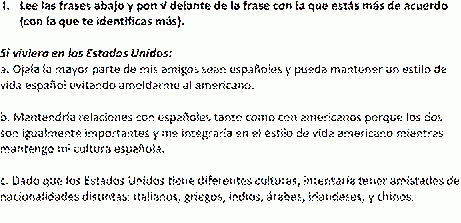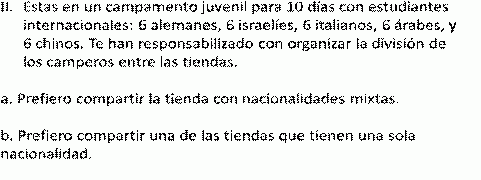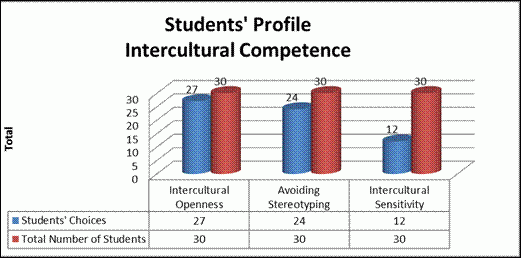Are our tertiary students interculturally competent?
RESUMEN
La competencia intercultural entendida como la apertura hacia otras culturas, evitando los estereotipos y la sensibilidad intercultural, se está revelando como una de las facetas de mayor importancia en los cada vez más frecuentes programas de intercambio entre los miembros de la comunidad académica (estudiantes y profesores). Efectuado un cuestionario a treinta estudiantes de la Universidad de San Jorge se ha podido constatar que la relación entre la apertura intercultural y la habilidad de evitar estereotipos es mayor que la relación de la propia apertura intercultural y la sensibilidad intercultural.
Palabras clave: educacción superior, competencia intercultural, apertura hacia otras culturas, sensibilidad intercultural, evitar los estereotipos
ABSTRACT
Intercultural competence among members of the academic community is now more in focus as a result of the increase in exchange programs and study-abroad periods. This small scale study reports the results gathered from the performance of thirty Journalism students on a questionnaire that was designed to measure their intercultural competence defined as: intercultural openness; avoiding stereotypes; and intercultural sensitivity). Results indicated that there is a stronger relationship between students’ performance on intercultural openness and avoiding stereotyping than between intercultural openness and intercultural sensitivity.
Keywords: tertiary education, intercultural competence; intercultural sensitivity, intercultural openness, avoiding stereotypes
1 . INTRODUCTION
Intercultural competence is one of the areas that receive least attention in bilingual programmes especially where Academic English or English for Specific Purposes (ESP) is concerned. The reason for this may be due to the perceived notion that interculturality is the outcome of upbringing, and life experiences, hence regarded as ‘a personal intake on matters regarding others’ that requires little or no interference. Also, this insufficient attention may be due to that intercultural competence is pertinent to fields other than language teaching that are more related to discourse analysis and identity studies that language teachers take for granted. Byram´s Intercultural Competence Model (1997 as cited in Deardorff, 2009) shows the synergy among motivation; political education; attitudes; knowledge; evaluation practices; interpretation skills; and interaction skills - all in no specific order - in the creation of a subsystem that we call intercultural competence, and which is eventually expressed in linguistic and sociolinguistic forms. Deardorff (2006) also affirms that intercultural competence is a lifelong process that language instruction alone cannot be made responsible for, but is surely a vehicle for learning about other cultures as well as a vehicle to learn about other’s worldviews. Since pragmatics and discourse are two areas that are more often tackled in applied linguistics, and because intercultural competence underlies thoughts and needs later verbalized through language utterances, it was chosen as the main topic for our study. In other words, if intercultural competence precedes appropriateness in language use, it is then valid that language educators would concern themselves with it as well.
The approach to the study lies within the Common European Framework of Reference for Languages (CEF, 2001). The CEF breaks down intercultural competence into several constructs aligned with Byram´s model among which are: the ability to overcome stereotyping; openness to people from other cultures; and cultural awareness and sensitivity. It is important to disentangle the differences between these constructs before proceeding further. Stereotyping is the result of a cognitive and psychological process that starts with the normal tendency to categorize individuals as either within-group or outside-group based on identity work, and the categorization of individuals in groups that are given labels and assigned definitions (Turner, 1982; Hewstone & Giles, 1986).
Negative stereotyping in particular involves passing negative judgments where a certain group is concerned. The ability to withhold the latter is indicative of the ability to avoid stereotyping. In regards to openness, the willingness to move beyond one’s comfort zone and approach new grounds (groups, cultures) with respect and curiosity indicates openness unto others (Deardorff, 2006), which is the second component outlined above. As for intercultural awareness, it can be seen as the knowledge-bound side of intercultural communicative competence achieved through learning by which individuals reach an understanding of cultural conventions that they later have to act upon when they are ready. If intercultural awareness is the knowledge-related cognitive aspect of intercultural competence, intercultural sensitivity can then be described as the affective aspect of the latter motivated by the willingness to avoid sensitivities and offences.
1.1 Point of Departure
Many universities in Spain are experiencing a process of internationalisation as a result of the Bolonia agreement. This small-scale study was carried out in the University of San Jorge in Zaragoza (USJ). In 2010, the university decided as part of its language policy that students would graduate with a B2 level in English and to take on other languages like French, Italian, German, and Chinese for which language courses are offered. The student profile is mostly Spanish; however, one degree programme (Physiotherapy) is dominated by French students, and there are some European students who arrive as part of the Erasmus programme (for example, Italians, Germans, Turkish). The teaching staff is also mostly Spanish, but nine percent are from a number of countries including England, Ireland, Denmark, China, Poland, Egypt as well as Latin America. The university is currently working towards attracting more students and teachers from different places in the world as part of its plan for internationalisation. In light of the latter, it becomes quite pressing to question whether our Spanish students are interculturally competent, besides being linguistically competent. Other than being curious about whether they were interculturally open, interculturally sensitive and could avoid stereotyping, two other questions were posed:
· Are culturally open students culturally sensitive?
· Do culturally open students avoid stereotyping?
2 . METHODOLOGY
2.1. Student Profile
Students in the Faculty of Communication - Journalism degree programme - were selected given that their future line of work requires they be interested in social and political events, people, and be ready to move outside their zone of comfort to cover different events. Thirty students belonging to a single class were given a questionnaire to elicit the data required for this study.
2.2. The Instrument
The questionnaire has four hypothetical situations and was written in Spanish to avoid students answering incorrectly to any part due to language problems.
The first situation taps into intercultural openness (see Figure 1 for the wording of the situation). It proposes a situation for students to hypothesize about a move to the United States. It then gives them three options. By choosing one of the three statements they either show preference to (1) have Spanish friendships mostly and avoid conformance to the American lifestyle, or (2) maintain relationships with Spanish and Americans equally and integrate both cultures into their lifestyles, or (3) extend their community of friends beyond the Americans to include other nationalities like Italians; Greeks; Indians; Arabs; Irish; and Chinese.

Figure 1. Student Questionnaire - Situation 1 (Intercultural Openness).
The second situation (see Figure 2 for the wording of the situation) also dealing with intercultural openness describes a situation where students are in a youth camp with six members of each of the following nationalities: Germans; Israelis; Italians; Arabs; and Chinese. Students are then asked if they would rather share a tent with mixed nationalities or be in a tent with only one of the nationalities above (Germans only, for example).

Figure 2. Student Questionnaire - Situation 2 (Intercultural Openness).
The third question was to see whether students had a tendency to stereotype or avoid stereotyping. They were asked if they agreed or disagreed to the following statement: “Germans are strict and do not have a sense of humour”.
The fourth question is an extension of question two and aims to see whether students are able to recognize culturally sensitive issues and avoid them. Whether students lack the knowledge or lack the affect (intercultural sensitivity) leading to their ability to make the appropriate choice, if they choose incorrectly, they would come across as interculturally insensitive. The task describes a situation where they are in the previously mentioned youth camp and have to choose one DVD to show the campers from among three available ones. The main theme of each movie is explained. Two of the movies are not suitable as they revolve around issues that could be culturally insensitive to the German, Israeli and Arab campers like the holocaust and the bombing of the twin towers in New York.
3. RESULTS & DISCUSSION
The answers of the students were tallied and their frequency count was transformed into percentages. For questions number one, 90% of the students expressed their willingness to have friendships with people from other nationalities besides maintaining their relationships with Spanish friends; conform to the American lifestyle while maintaining their Spanish culture. For question number two, 90% of the students as well, chose to share tents with mixed nationality. For question number three, 80% of the students stated they disagreed to the statement regarding Germans being strict and lacking a sense of humour. For the fourth and final question, only 40 % of the students were able to identify the movie that could be viewed by all campers causing offense to any of the present nationalities while 60% could not.

Figure 3. The intercultural competence profile of Journalism first-year students at USJ.
Figure 3 shows a comparison between students’ performance on all three aspects measured in this study. The graph shows that students performed better on the first aspect – intercultural openness – when compared to avoiding topics that could cause sensitivity or unease to members of other cultures. Pearson correlations were calculated to compare students’ performances among the three aspects. A coefficient of r=0.66 and r=0.27 were found respectively between intercultural openness and avoiding stereotyping, and between intercultural openness and avoiding intercultural sensitivity. To conclude, students were found to be interculturally open and able to avoid stereotyping, in general. In regards to relationships between performances, Interculturally open students seemed more likely to avoid stereotyping while the very low correlation between intercultural openness and intercultural sensitivity suggests that there is no relationship between the latter two.
4. RECOMMENDATIONS
Though foreign language teachers often complain of the lack of time to attend to the many areas of language communicative competence, it is neither really challenging nor time-consuming to integrate activities or tasks that are situation-based, for example, similar to the questionnaire used in this study.The questionnaire was used here as an assessment tool, but if the situations and results are discussed with the students, it would serve as a tool for awareness-raising as well. It is not a new concept that assessment tools could be used as teaching tools; one of the objects of assessment is learning. Language and culture have often gone hand in hand. Language opens the way to talking about culture and vice versa. It is recommended that speaking or conversation classes would take on topics that discuss stereotyping, or debate issues that may be the cause of intercultural sensitivity while still attending to linguistic objectives. Teachers of Language for Specific Purposes have to do the latter to function on the content-language continuum; if the specific purpose is made to be intercultural competence from time-to-time, the objective of raising students’ awareness and raising their competence in the area in question could be achieved at no extra expense to teaching time. As Kramsch (1996) puts it: ”It is because of that mediatory role of language that culture becomes the concern of the language teacher...language plays a crucial role not only in the construction of culture, but in the emergence of cultural change”.
Council of Europe, (2001). Common European Framework of Reference for Languages: Learning, teaching, assessment. Cambridge: Cambridge University Press.
Deardorff, Darla K. (2006). The Identification and Assessment of Intercultural Competence as a Student Outcome of Internationalization at Institutions of Higher Education in the United States. Journal of Studies in International Education. 10. 241-266
Kramsch, Claire. (1996). The Cultural Component of Language Teaching.
Zeitschrift für Interkulturellen Fremdsprachenunterricht [Online], 1(2). Retrieved online from: http://www.spz.tudarmstadt.de/projekt_ejournal/jg_01_2/beitrag/kramsc2.htm
Deardorff, Darla K. (2006). The Identification and Assessment of Intercultural Competence as a Student Outcome of Internationalization at Institutions of Higher Education in the United States. Journal of Studies in International Education. 10. 241-266
Deardorff, D.K. (ed). (2009). The Sage Handbook of Intercultural Competence. Sage.
Turner, J. (1982). Towards a cognitive redefinition of the social group. In H. Tajfel (ED.), Social Identity and intergroup relations (pp. 15-40). Cambridge, England; Cambridge University Press.
Hewstone, M., & Giles, H. (1986). Social groups and social stereotypes in intergroup communication: A review and model of review intercommunication breakdown. In W. Gudykunst (Ed.), Intergroup communication (pp. 10-26). London. Edward Arnold.